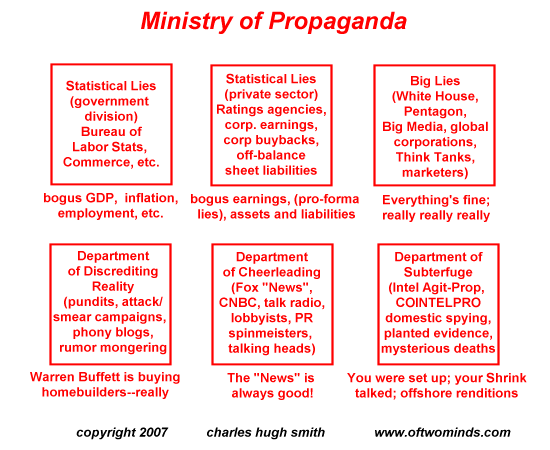This article is by David Kotok of Cumberland Advisors. I try not to read this type of "research" from money managers who are essentially "talking their book", but occasionally the headline or subject is so interesting that I'm hooked and drawn in.
His description of the current situation is quite good; it's the conclusions he draws that I take issue with. Of course, if one believes that "Bubbles Ben" will not monetize the US Government's debt then Kotoc would likely be correct. The problem for me is that I don't believe anything Bernanke says, and history is on my side.
His description of the current situation is quite good; it's the conclusions he draws that I take issue with. Of course, if one believes that "Bubbles Ben" will not monetize the US Government's debt then Kotoc would likely be correct. The problem for me is that I don't believe anything Bernanke says, and history is on my side.
| 2010: The Year to Focus on Sovereign Debt December 23, 2009 David Kotok, Chairman & Chief Investment Officer |
|
| Abstract: Sovereign debt is likely to be the big headline issue for 2010. This commentary will look at some debt-related issues of Greece and California in their two respective currency zones and then discuss our view of sovereign debt markets for 2010, particularly with respect to the US dollar and euro currency zones. Some strategy guidance for portfolio management of debt will wrap things up. "Whatever it is, I fear the Greeks even when they bring gifts." This is one of the English translations of Virgil's Aeneid. It refers to the Trojan horse that Greece used to deceive Troy and gain entry into the city. "During the Depression about half the population of Oklahoma moved to California and the intelligence level in both states went up." Will Rogers, the great American commentator from Oklahoma, hatched this quip decades ago in his analysis of California's governmental policies and its finances. If we were writing a play on the theme of sovereign debt, we might use the following characterization. The US and the EU are the setting: two currency zones. The Fed and the ECB are the dominant members of the cast: two central banks responsible for the two currencies. Greece and California are in leading roles: two states within the two currency zones. In the United States, California constitutes about 13% of America's GDP. If CA were a standalone economy, it would be about the seventh largest in the world. The currency in use in California is the US dollar. The CA government determines its own budget, has its own constitution, operates an internal legal system, and decides its own state tax structure. It is also one of the 50 sovereign members of the USA and has legally bound itself to the rules promulgated in Washington, while attempting to preserve some state rights within our highly federalized legal system. CA and most other states have a requirement to balance an annual budget. There are provisions for emergencies in many of these states, and in the coming year we expect the concept of a financial emergency to be deployed and tested in various state courts. CA recently issued "scrip" during a short-lived budget crisis when it ran out of cash and until its legislature passed a revised budget. That was not the first time script has been used. We do not expect it will be the last. In the euro zone, Greece is about 3% of the GDP. It is a sovereign state (country), one of the 16 members of the euro monetary system, and one of the 27 members of the European Union. GR maintains its own budget, although it has pledged to adhere to EU budget rules, which it is currently violating along with most other members of the EU. Under present agreements, penalties will occur if GR is not making a sufficient effort to improve its fiscal situation within a year. We do not expect those penalties to be imposed on GR nor on the other EU states in difficulty. Greece has its own tax structure, constitution, and internal legal system. GR is also covered by the newly developed EU Lisbon Treaty and, like other EU member states, is gradually moving into a Europe-wide economic structure. California and Greece are both lowly rated by the agencies that appraise the creditworthiness of sovereign debt. CA and GR are also on the top of the list of possible default candidates in their respective currency zones. That list is prepared by CMA DataVision, a service that scrutinizes credit default swap pricing in order to determine market-based assessments of default probability over the next five years. CA and GR are both poorly rated, and their scores (default probabilities) are about the same. CA is a problem for the Federal Reserve because the state is a very large part of the US economy and because it is suffering from the financial crisis and the collapse of the housing bubble. If CA defaults, it will lose access to credit markets and contract a governmental economy that is 1/7 of the US. That would be a huge blow to the nascent American economic recovery. ... http://www.cumber.com/commentary.aspx?file=122309.asp |


Comment